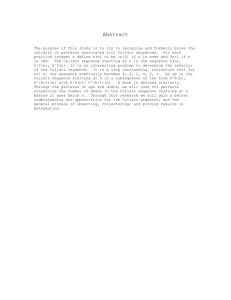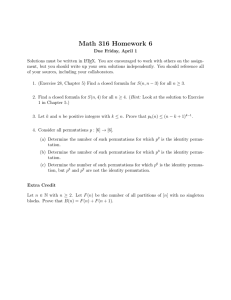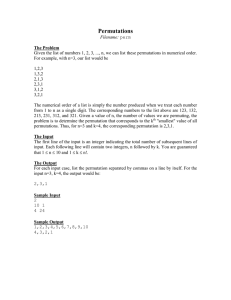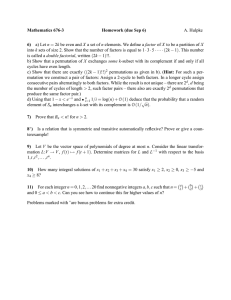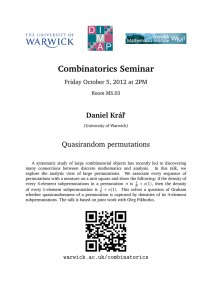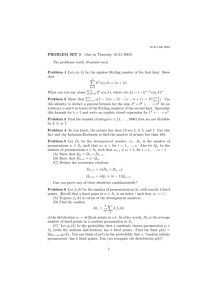Collatz Conjecture and Fibonacci Numbers: Permutation Analysis
advertisement
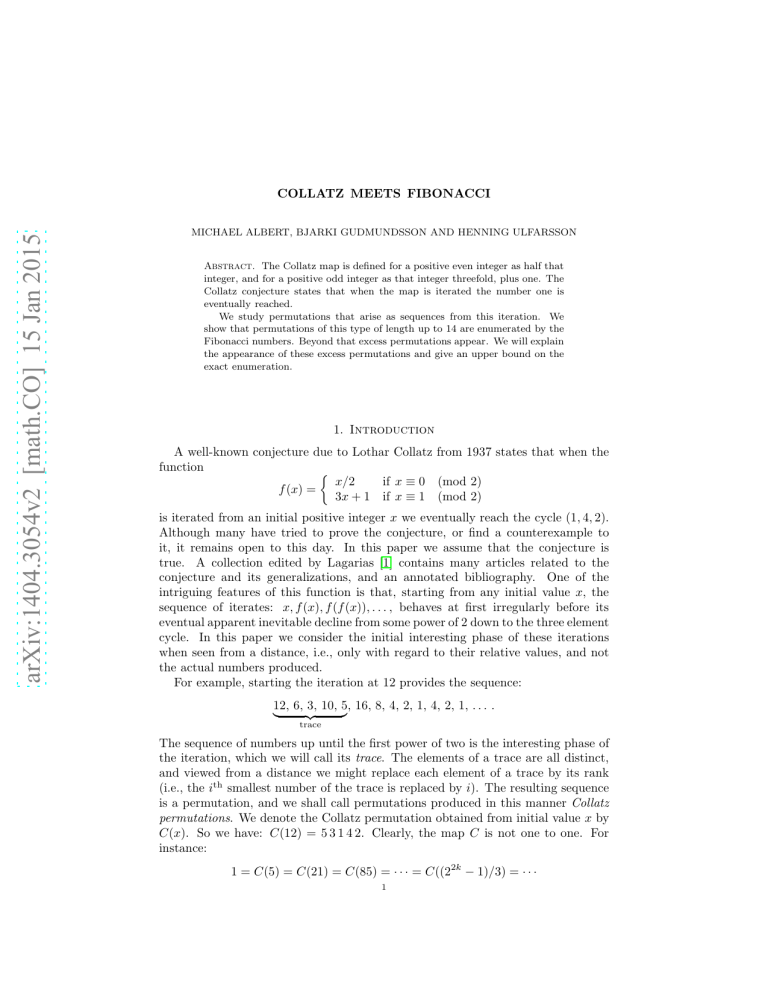
arXiv:1404.3054v2 [math.CO] 15 Jan 2015
COLLATZ MEETS FIBONACCI
MICHAEL ALBERT, BJARKI GUDMUNDSSON AND HENNING ULFARSSON
Abstract. The Collatz map is defined for a positive even integer as half that
integer, and for a positive odd integer as that integer threefold, plus one. The
Collatz conjecture states that when the map is iterated the number one is
eventually reached.
We study permutations that arise as sequences from this iteration. We
show that permutations of this type of length up to 14 are enumerated by the
Fibonacci numbers. Beyond that excess permutations appear. We will explain
the appearance of these excess permutations and give an upper bound on the
exact enumeration.
1. Introduction
A well-known conjecture due to Lothar Collatz from 1937 states that when the
function
x/2
if x ≡ 0 (mod 2)
f (x) =
3x + 1 if x ≡ 1 (mod 2)
is iterated from an initial positive integer x we eventually reach the cycle (1, 4, 2).
Although many have tried to prove the conjecture, or find a counterexample to
it, it remains open to this day. In this paper we assume that the conjecture is
true. A collection edited by Lagarias [1] contains many articles related to the
conjecture and its generalizations, and an annotated bibliography. One of the
intriguing features of this function is that, starting from any initial value x, the
sequence of iterates: x, f (x), f (f (x)), . . . , behaves at first irregularly before its
eventual apparent inevitable decline from some power of 2 down to the three element
cycle. In this paper we consider the initial interesting phase of these iterations
when seen from a distance, i.e., only with regard to their relative values, and not
the actual numbers produced.
For example, starting the iteration at 12 provides the sequence:
12, 6, 3, 10, 5, 16, 8, 4, 2, 1, 4, 2, 1, . . . .
{z
}
|
trace
The sequence of numbers up until the first power of two is the interesting phase of
the iteration, which we will call its trace. The elements of a trace are all distinct,
and viewed from a distance we might replace each element of a trace by its rank
(i.e., the ith smallest number of the trace is replaced by i). The resulting sequence
is a permutation, and we shall call permutations produced in this manner Collatz
permutations. We denote the Collatz permutation obtained from initial value x by
C(x). So we have: C(12) = 5 3 1 4 2. Clearly, the map C is not one to one. For
instance:
1 = C(5) = C(21) = C(85) = · · · = C((22k − 1)/3) = · · ·
1
2
MICHAEL ALBERT, BJARKI GUDMUNDSSON AND HENNING ULFARSSON
However, as the length of C(x) increases, coincidences become more rare, e.g., the
only other x ≤ 1000 with C(x) = C(12) is x = 908. It seems natural to ask: Among
the permutations of length n, how many are Collatz permutations?
Considering only those x ≤ 108 for which the length of C(x) is at most 7 produces
Table 1. As the reader will have noticed the values in the table are the Fibonacci
Length Collatz permutations
1
1
2
1
3
2
4
3
5
5
6
8
7
13
Table 1. Number of Collatz permutations of length less than 8 (experimentally).
numbers. In what follows we will explain this phenomenon and show that it persists
through length 14. Beyond that point, excess permutations appear – and we will
explain how and why this occurs as well.
2. Types of traces
The appearance of the Fibonacci numbers in the enumeration of Collatz permutations is easy to explain. The steps that occur in a trace are of two types depending
on the parity of the argument. We can call them: up steps (x 7→ 3x + 1 when x is
odd) denoted by u; and down steps (x 7→ x/2 when x is even) denoted by d. Two
up steps can never occur consecutively since 3x+1 is even when x is odd1. The step
types in a trace can be recovered from the resulting Collatz permutation according
to the pattern of rises and descents. We call the resulting sequence of u’s and d’s
the type of the trace. As well as not containing consecutive u’s, the last symbol in
such a sequence must be a d (since there is a “hidden” u occurring next to take us
to a power of 2). As is well known, the number of such sequences of length n is
given by Fn , the nth Fibonacci number (with F1 = F2 = 1 and Fn = Fn−1 + Fn−2
for n > 1).
So, in order to show that there are at least Fn Collatz permutations of length n
it will be enough to show that any sequence of u’s and d’s satisfying the necessary
conditions above actually occurs as the type of some trace. To prove this, it is
helpful to turn our focus to the end of a trace, rather than its beginning.
The final element of any trace is always a number of the form (A − 1)/3 where
A = 2a (of course a must be even but we will be making further requirements
shortly, so ignore this for the moment). Think of u and d as functions and let their
inverses be denoted U and D, that is:
U (x) = u−1 (x) = (x − 1)/3
and
D(x) = d−1 (x) = 2x.
A witness for a type, σ, is an A = 2a such that there is a trace ending at (A − 1)/3
with type σ. For example, to find a witness for the type uddud requires at least that
1Of course this is why some authors consider the “fundamental” steps of the Collatz iteration
to be x 7→ (3x + 1)/2 for odd x, and x 7→ x/2 for even x.
COLLATZ MEETS FIBONACCI
3
U DDU DU (A) be an integer. Note here that the “hidden u” has become explicit,
and that the order of U ’s and D’s in the functional application is the same as
that in the type – because the type is written in the reverse of “normal” function
application order! Now
8A − 29
.
27
In order for this to be an integer requires A = 7 (mod 27), and remembering that
A = 2a , the least solution to this is A = 216 = 65536. Unraveling the applications
of U ’s and D’s leads to x = 19417. The trace of x is
U DDU DU (A) =
19417, 58252, 29126, 14563, 43690, 21845,
and C(x) = 2 6 4 1 5 3.
We now check that, given a type σ, it is enough to find a witness A in this
way (i.e., that the initial necessary integrality condition is also sufficient) and that
infinitely many witnesses always exist.
Proposition 1. If a type σ contains k u’s then there is a single congruence of the
form A = c (mod 3k+1 ) which must be satisfied in order that a trace of type σ ends
with witness A. Consequently, there is a least witness A = 2a with a ≤ 2 · 3k , and a
general witness is of the form 2a+jd where j is a nonnegative integer and d = 2 · 3k .
Proof. From σ construct the sequence, Σ of U ’s and D’s obtained by changing each
u to U and each d to D and then appending a U . Now compute Σ(A) formally
obtaining an expression of the form:
2m A − b
3k+1
where m is the number of d’s in σ and k the number of u’s. In order that A
be a witness to a trace of type σ it is necessary that this be an integer which,
since 2 and 3k+1 are relatively prime, leads to a necessary condition of the form
A = c mod 3k+1 . To see that this condition is also sufficient suppose inductively,
that Γ(A) ∈ Z for some suffix Γ of Σ. If Γ begins with D then formally Γ(A) =
(2k A − 2b)/3m for some k > 0 and integer b. If this is an integer then so is
dΓ(A) = (2k−1 A − b)/3m which is the next element of the trace we are trying to
construct. The case when Γ begins with U is easier since uΓ(A) = 3Γ(A) + 1 and so
is still an integer as well. To finish, note that it is well known that 2 is a primitive
root modulo 3k for all k, and the remaining claims are simple consequences of that
fact.
This proposition shows that every potential type has a witness and thereby
proves that there are at least Fn Collatz permutations of length n.
Table 2 shows that there are exactly Fn Collatz permutations of length n for
n = 1, 2, . . . , 14 but for greater n there are more.
The shortest type that is associated with more than one Collatz permutation is
the type σ = uddudududduddd which has the integrality condition 2a = 16 mod
729. The smallest solution to this equation is a = 4 corresponding to the trace
9, 28, 14, 7, 22, 11, 34, 17, 52, 26, 13, 40, 20, 10, 5 and the first permutation in Figure 1.
However, the next solution to the integrality condition is a = 490. The initial
number corresponding to this solution produces a different permutation than the
smaller initial number, and is shown in the second line in Figure 1.
4
MICHAEL ALBERT, BJARKI GUDMUNDSSON AND HENNING ULFARSSON
length #perms
1
1
2
1
3
2
4
3
5
5
6
8
7
13
8
21
9
34
10
55
11
89
12
144
13
233
14
377
length #perms excess
15
611
1
16
989
2
17
1600
3
18
2587
3
19
4185
4
20
6771
6
21
10953
7
22
17720
9
23
28669
12
24
46383
15
25
75044
19
26
121417
24
27
196448
30
28
317850
39
29
514278
49
30
832101
61
31
1346346
77
32
2178405
96
Table 2. Number of Collatz permutations of length less than 32
3
4
12 7 2
12 7 2
10 5 13 8
10 5 13 8
15 11 6 14 9
15 11 6 14 9
4
3
1
1
Figure 1. Two different permutations associated with the type uddudududduddd
In the next section we will explain why this type gives us two different permutations and when this should be expected.
3. Excess permutations
How can one type correspond to different permutations? Consider the type
σ = dududd. If we are considering a potential witness t for it, then the trace that
would be generated is:
DU DU DDU (t), U DU DDU (t), DU DDU (t), . . . , DU (t), U (t).
Thought of as linear functions of t these lines are shown in Figure 2. We find a
witness for the type wherever we find a vertical line t = A where A = 2a and all
the intersection points of t = A with these lines are at integer heights. We can then
read off the relative order of the lines at this point according to the order they are
crossed as we move up the line t = A from the t-axis.
Consequently we see that if we have two potential witnesses such that there is
no intersection point between two lines in the corresponding family lying between
them, that they will determine the same permutation. On the other hand, if there
were a witness between every pair of intersections of the lines for a type, and
if these
intersections all occurred at distinct abscissae, we might have up to n2 witnesses
for any given type producing distinct permutations. However, we can rule out such
a wealth of witnesses quite easily as we can show that the second potential witness
COLLATZ MEETS FIBONACCI
5
5
3
6
1
4
7
2
6.25
28
t
Figure 2. Linear functions determining permutations associated
with the type dududd. The labels on each line correspond to the
point that the corresponding element would occur in a trace and
so the permutation associated with the intersections on the line
x = 28 is 4 1 6 3 7 5 2.
always lies to the right of the rightmost intersection point among the lines. That
is:
Proposition 2. For any type σ there are at most two distinct permutations C(x)
arising from x of type σ.
Proof. Suppose that σ contains k occurrences of u. The values of a for which
A = 2a are witnesses form an arithmetic progression with common difference 2 · 3k ,
k
and in particular, the second witness is greater than 22·3 . On the other hand we
can crudely bound the greatest abscissa of a point of intersection between the lines
arising from σ as follows. Suppose that we have two such lines, one resulting from
a suffix of Σ (notation as above) containing p occurrences of D and q occurrences of
U (call this the pq-line), and the other from a longer suffix containing r occurrences
of D and s occurrences of U (call this the rs-line). Suppose that the y intercept of
the pq-line is less than that of the rs-line. The y-intercept of the pq-line is certainly
greater than −2p−q , while that of the rs-line is less than or equal to 0. So their
intersection occurs to the left of the x-value determined by:
2p
2r
x − 2p−q = s x
q
3
3
which is
2p−q
3s
x= p
2 − 2r 3s−q
In the other case, the rs-line has lesser y-intercept than the pq-line. Using similar
bounds gives an intersection point to the left of
2r−s
3s .
2r − 2p 3s−q
In both estimates the denominator is a non-zero integer multiple of 2p (since p ≤ r
and q ≤ s and at least one of these inequalities is strict) and hence the first factors
x=
6
MICHAEL ALBERT, BJARKI GUDMUNDSSON AND HENNING ULFARSSON
are bounded by 2−q 3s and 2r−s−p 3s respectively. Therefore, x ≤ 3s ≤ 3k <
k
22·3 .
Recall that the type σ = uddudududduddd had witnesses 24 , 2490 , . . . . The
greatest abscissa of an intersection point for the lines arising from this sequence is
approximately 44.04. The first two witnesses are clearly on different sides of this
intersection, explaining why we get two different Collatz permutations.
Propositions 1 and 2 show that the number of types of length n lies between
Fn and 2Fn . Moreover, the arguments leading up to Proposition 2 allow one to
compute, given a type whether it corresponds to one or two types, and it is by these
means that the data of Table 2 were derived.
To get an exact enumeration of the Collatz permutations one would need to
understand which types are associated with two permutations. We call these excess
creating types (ET’s). Given an ET we can always create a new ET by prepending
a d. This is because the extra d does not alter the integrality condition and can
only increase the maximum intersection point. This at least shows that the number
of ET’s is non-decreasing.
4. Future work
As with so many aspects of the whole Collatz disease, a few answers just seem
to lead to more questions.
•
• How exactly does the number en of ET’s of length n behave? The data
above suggests that it might be something like “half Fibonacci rate” i.e.,
roughly proportional to the square root of the nth Fibonacci number, or
equivalently satisfy ing en ∼ en−2 + en−4 .
• In our current dataset we always get c = 16 in the integrality conditions for
ET’s. This is probably just a result of our search procedure having explored
only “small” values – but perhaps it might be a necessary condition.
• We have an extrinsic way of creating the Collatz permutations: run the
Collatz process and see what comes out. Is there an intrinsic way to recognize these permutations, beyond the obvious condition that they cannot
contain consecutive rises?
• There are several other maps similar to the Collatz map and there is also
the modified Collatz sequence (where u is replaced with ud), as well as the
Syracuse function where long down-steps are collapsed into one down-step.
How do these analyses transfer to those contexts?
For the reader who is eager to start exploring Collatz permutations, we have a
small code library supporting some basic features for working with their types. The
code is written in the Sage open-source mathematics software system, but should
run in Python with minor modifications. The code can be found at https://github.com/SuprDewd/CollatzPerm
5. Acknowledgment.
The authors are grateful to William Stein for access to the Sage Combinat Cluster, supported by NSF Grant No. DMS-0821725.
COLLATZ MEETS FIBONACCI
7
References
[1] Jeffrey C. Lagarias, editor). The Ultimate Challenge: the 3x + 1 Problem. American Mathematical Society, Providence, RI, 2010.
